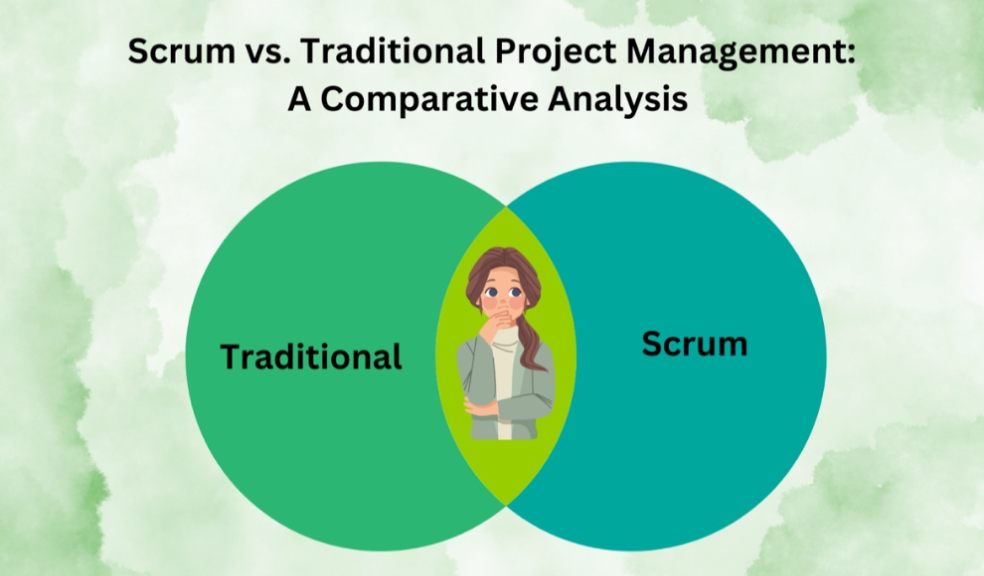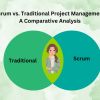
Scrum vs. Traditional Project Management: A Comparative Analysis
Two prominent approaches, Scrum and Traditional Project Management, are diametrically opposed cornerstones in project management. Agile framework Scrum promotes flexibility, teamwork, and iterative development. It does well in situations that are constantly changing. For those who like to work in project management, Scrum Training is critical to understanding the methodology in detail, along with the Advantages and Disadvantages of Scrum.
On the other hand, traditional project management, best represented by the waterfall model, is based on a sequential, linear methodology appropriate for projects with consistent, well-defined needs. This blog takes a comparative approach, breaking down the differences between both approaches, examining their unique qualities, and offering predictions about which one would win out in the race for a project's successful completion.
Table Of Contents
- Understanding Scrum
- Understanding Traditional Project Management
- Comparative Analysis
- Conclusion
Understanding Scrum
Scrum is a foundational Agile framework that redefines project management by placing a strong focus on cooperation and adaptability. Fundamentally, Scrum breaks down projects into time-boxed iterations, or sprints, that run two to four weeks on average.
The Development Team, the Product Owner, and the Scrum Master are important positions that promote a cross-functional, self-organising environment. The dynamic series of activities known as sprint planning, daily scrum, sprint review, and sprint retrospective form the basis of scrum, guaranteeing ongoing communication, flexibility, and progress.
The framework is a powerful option for projects where change is not only expected but welcomed because of its simplicity, transparency, and iterative nature.
Key components of Scrum include
Roles
- Scrum Master: Facilitates the team and makes sure the Scrum principles are followed.
- Product Owner: Sets priorities for the backlog and represents the stakeholders.
- Development Team: Cross-functional development team members oversee producing the final product.
Artifacts
- Product Backlog: A prioritised collection of features and specifications is called a product backlog.
- Sprint Backlog: Features chosen for this sprint are listed in the sprint backlog.
- Increment: The total of all finished product backlog items is the increment.
Events
- Sprint Planning: Starts with the sprint planning session.
- Daily Scrum: Quick daily get-togethers to ensure team cohesion.
- Sprint Review: At the sprint's end, a demonstration of the finished work is given.
- Sprint Retrospective: After every sprint, a moment of reflection and progress is made.
Understanding Traditional Project Management
Conventional project management employs an organised, sequential methodology, best represented by the Waterfall model. With its five separate phases (planning, execution, monitoring, and closure), it is best suited for projects whose requirements are well-defined and consistent.
This method is characterised by a sequential flow and thorough documentation. Following the launch of the project plan, modifications are discouraged. Formalised communication is used, and client participation is restricted to certain phases.
Conventional project management prioritises control and seeks to fully comprehend the project before it is carried out. It provides a clear roadmap for projects where predictability and a methodical approach are priorities, but it is less flexible when needs change.
Key components of Traditional Project Management include:
Phases
- Initiation: Setting the project's goals and definition is the first step.
- Planning: Defining the parameters, timetable, and resources of a project.
- Execution: Putting the project plan into action.
- Monitoring: Keeping tabs on the progress of a project and adjusting as needed.
- Closure: Completing the work and distributing the finished product.
Control
- A focus on documentation and control.
- Once the project has commenced, modifications are discouraged.
Comparative Analysis
Flexibility
- Scrum: Extremely flexible in response to evolving project requirements.
- Conventional Project Management: Once the project plan is set, there is little room for modification.
Communication and Collaboration
- Scrum: Places a strong emphasis on teamwork and daily communication.
- Conventional Project Management: There is typically more formal and structured communication.
Risk Management
- Scrum: Throughout the project, risks are continuously identified and addressed.
- Conventional Project Management: Planning is usually when risk analysis takes place.
Client Involvement
- Scrum: Promotes regular client participation and feedback.
- Conventional Project Management: The client is primarily involved in the requirements collecting and project delivery phases.
Delivery Time
- Scrum: Through incremental development, it enables faster delivery.
- Traditional Project Management: Due to the sequential nature of the procedure, delivery times are longer.
Documentation
- Scrum: Prioritises functional software over extensive documentation.
- Conventional Project Management: An essential component of the approach is thorough documentation.
Change Management
- Scrum: Accepts modifications even at the very end of the development cycle.
- Conventional Project Management: Making changes is frequently met with resistance or substantial obstacles.
Conclusion
This comparison of Scrum vs Traditional Project Management concludes with the realisation that neither methodology is a one-size-fits-all. The type of project, the level of adaptability needed, and the expectations of stakeholders all play a role in which methodology is selected. Because of its adaptability, quick delivery cycles, and teamwork-focused methodology, Scrum is a great choice for projects whose needs change frequently and feedback must be given continuously.
Conversely, Traditional Project Management offers stability and control due to its sequential and organised form, which makes it appropriate for projects with set needs that don't change. Organisations are beginning to see the benefits of a hybrid approach, which combines aspects of traditional project management and scrum to produce a customised methodology that meets the specific needs of each project. Understanding the subtleties of each approach and strategically implementing them to achieve project success in a variety of ever-changing and different settings is crucial in this dynamic world.














